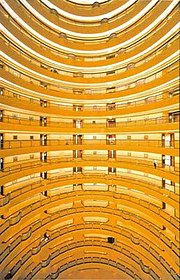Andreas Gursky
From Wikipedia, the free encyclopedia
| This article needs references that appear in reliable third-party publications. Primary sources or sources affiliated with the subject are generally not sufficient for a Wikipedia article. Please add more appropriate citations from reliable sources. (December 2008) |
Andreas Gursky (1955) is a German photographer known for his enormous architecture and landscape color photographs, often employing a high point of view. He is represented by the Matthew Marks Gallery in New York and by Monika Spruth Philomene Magers in Berlin and London.
Contents |
[edit] Education
He was born in Leipzig in 1955, but he grew up in Düsseldorf, the son of a commercial photographer. In the early 1980s, at Germany's State Art Academy, the Kunstakademie Düsseldorf, Gursky received strong training and influence from his teachers Hilla and Bernd Becher,[1] a photographic team known for their distinctive, dispassionate method of systematically cataloging industrial machinery and architecture.[original research?] A similar approach may be found in Gursky's methodical approach to his own, larger-scale photography. Other notable influences are the British landscape photographer John Davies, whose highly detailed high vantage point images had a strong effect on the street level photographs Gursky was then making, and to a lesser degree the American photographer Joel Sternfeld.
[edit] Career and style
Before the middle 1990s, Gursky did not digitally manipulate his images.[citation needed] In the years since, Gursky has been frank about his reliance on computers to edit and enhance his pictures, creating an art of spaces larger than the subjects photographed.[citation needed] Writing in The New Yorker magazine, the critic Peter Schjeldahl called these pictures "vast," "splashy," "entertaining," and "literally unbelievable."[2] In the same publication, critic Calvin Tomkins described Gursky as one of the "two masters" of the "Düsseldorf" school. In 2001, Tomkins described the experience of confronting one of Gursky's large works:[1]
- "The first time I saw photographs by Andreas Gursky...I had the disorienting sensation that something was happening—happening to me, I suppose, although it felt more generalized than that. Gursky's huge, panoramic color prints—some of them up to six feet high by ten feet long—had the presence, the formal power, and in several cases the majestic aura of nineteenth-century landscape paintings, without losing any of their meticulously detailed immediacy as photographs. Their subject matter was the contemporary world, seen dispassionately and from a distance."[1]
Visually, Gursky is drawn to large, anonymous, urban spaces—high-rise facades at night, office lobbies, stock exchanges, the interiors of big box retailers (See his print 99 Cent II Diptychon). In a 2001 retrospective, New York's Museum of Modern Art called the artist's work, "a sophisticated art of unembellished observation. It is thanks to the artfulness of Gursky's fictions that we recognize his world as our own."[3] Gursky’s style is enigmatic and deadpan. There is little to no explanation or manipulation on the works. His photography is straightforward. [4]
Gursky's Dance Valley festival photograph, taken near Amsterdam in 1995, depicts attendees facing a DJ stand in a large arena, beneath strobe lighting effects. The pouring smoke resembles a human hand, holding the crowd in stasis. After completing the print, Gursky explained the only music he now listens to is the anonymous, beat-heavy style known as Trance, as its symmetry and simplicity echoes his own work—while playing towards a deeper, more visceral emotion.[citation needed]
As of early 2007, Gursky holds the record for highest price paid at auction for a single photographic image. His print 99 Cent II, Diptych, sold for GBP 1.7 million (USD $3.3 million) at Sotheby's, London.[5]
[edit] References
- ^ a b c Tomkins, Calvin. The New Yorker. "The Big Picture." 22 January, 2001.
- ^ Schjeldahl, Peter. The New Yorker. "Reality Clicks." 27 May, 2002.
- ^ Museum of Modern Art. "Andreas Gursky." Exhibition Catalog, 2001
- ^ David Grosz (June 1, 2007), From Shore to Gursky, Part I, ARTINFO, http://www.artinfo.com/news/story/25152/from-shore-to-gursky-part-i/, retrieved on 2008-04-16
- ^ Public Lot Details, February, 2007
[edit] See also
[edit] Exhibitions
- 1989 Museum Haus Lange, Krefeld; Centre Genevois de Gravure Contemporaine, Geneva, Switzerland
- 1992 Kunsthalle Zürich, Switzerland
- 1994 Deichtorhallen, Hamburg; De Appel Foundation, Amsterdam, Netherlands; Kunstmuseum Wolfsburg
- 1995 Portikus Frankfurt; Rooseum, Malmö, Sweden; Tate Liverpool, England
- 1998 Kunsthalle Düsseldorf; Kunstmuseum Wolfsburg; Fotomuseum Winterthur, Switzerland; Milwaukee Art Museum, Milwaukee, USA; Museum of Contemporary Arts, Houston, USA
- 1999 Serpentine Gallery, London, England; Scottish National Gallery of Modern Art, Edinburgh, Scotland; Castello di Rivoli, Turin, Italy
- 2000 Sprengel Museum, Hannover; Galerie für Zeitgenössische Kunst, Leipzig; Busch-Reisinger Museum, Havard University, Cambridge, USA
- 2001 Museum of Modern Art, New York, USA; Museum of Contemporary Art, Chicago, USA; Museo Nacional Centro de Arte Reina Sofía, Madrid, Spain; Centre Georges Pompidou, Paris, France;
- 2003 San Francisco Museum of Modern Art, San Francisco, U.S.
- 2005 Kunstmuseum Wolfsburg; Juan March Institute, Madrid, Spain
- 2007 Haus der Kunst, Munich, Germany
- 2007 White Cube, London, England
- 2007 Kunstmuseum Basel, Basel
- 2007 Istanbul Modern, Istanbul, Turkey
- 2007 Matthew Marks Gallery, New York, U.S.
- 2008 Exhibition Building Mathildenhöhe, Darmstadt, Germany
- 2008 Museum für Moderne Kunst, Frankfurt am Main, Germany
- 2008 Ekaterina Cultural Foundation, Moscow, Russia
- 2008 PinchukArtCentre, Kiev, Ukraine
- 2008 Haus Lange/Haus Ester, Krefeld
- 2008-2009 National Gallery of Victoria International, Melbourne, Australia
[edit] External links
- Andreas Gursky at the Matthew Marks Gallery
- Ralph Rugoff on Andreas Gursky
- 2001 Exhibition of Andreas Gursky @ MOMA.
- Gursky's "99 Cent" Prints Fetch Millions At Auction November 29, 2006
- A Podcast Considering the work of Andreas Gursky.
- A.Gursky - Solo Exhibition 2007 in Munich
- Andreas Gursky: from a World Spirit's-eye view
- Portrait of the artist by the Goethe-Institut
- Andreas Gursky’s Personal Exhibition in the Ekaterina Cultural Foundation
- Andreas Gursky, Kunstmuseum Basel Video at VernissageTV.




